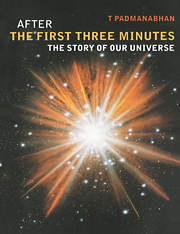2 - Matter, radiation and forces
Published online by Cambridge University Press: 02 November 2009
Summary
A microscopic tour
The physical conditions which exist in the centre of a star, or in the space between galaxies, could be quite different from the conditions which we come across in our everyday life. To understand the properties of, say, a star or a galaxy, we need to understand the nature and behaviour of matter under different conditions. That is, we need to know the basic constituents of matter and the laws which govern their behaviour.
Consider a solid piece of ice, with which you are quite familiar in everyday life. Ice, like most other solids, has a certain rigidity of shape. This is because a solid is made of atoms – which are the fundamental units of matter – arranged in a regular manner. Such a regular arrangement of atoms is called a ‘crystal lattice’, and one may say that most solids have ‘crystalline’ structure (see figure 2.1). Atoms, of course, are extremely tiny, and they are packed fairly closely in a crystal lattice. Along one centimeter of a solid, there will be about one hundred million atoms in a row. Using the notation introduced in the last chapter, we may say that there are 108 atoms along one centimeter of ice. This means that the typical spacing between atoms in a crystal lattice will be about one part in hundred millionth of a centimeter, i.e., about 1/100 000 000 centimeter. This number is usually written 10−8 cm. The symbol 10−8, with a minus sign before the 8, stands for one part in 108; i.e., one part in 100 000 000.
- Type
- Chapter
- Information
- After the First Three MinutesThe Story of Our Universe, pp. 8 - 45Publisher: Cambridge University PressPrint publication year: 1998

